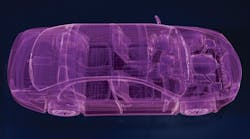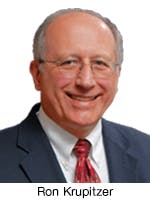Advances in technology are speeding the integration of electronic and mechanical systems on the plant floor, especially as the automotive industry business picks up in North America. MPT Drives, which specializes in power transmission, is seeing a steady uptick in that business due to rebounding economic conditions and advancing technology. Based in Madison Heights, Mich., the company primarily deals with original equipment manufacturers (OEMs).
Keith Nowak, president of MPT Drives, has seen a steady rise in product and system innovations over the years. For example, items that were primarily chain and sprocket-driven have become more technologically sophisticated.
“In general, a lot of the stuff that we sold were big drives. So you’d have gearboxes, sprockets,” Nowak said. “A lot of that has been replaced by variable frequency drives where you can slow down speeds with electronics instead of the old-fashioned sprocket and chain.”
Such advances allow Nowak and MPT’s customers to do more with less.
“What used to take 50 horsepower now you can usually do with 25 horsepower,” he said. “We sell a lot of gearboxes. The technology in gearboxes is such that you can use less horsepower and it can do more work than it did before.”
In addition, the revitalization of the auto industry calls for new and larger warehouses that are prime targets for automation, a need companies such as MPT are ready to fill.
“Basically, it’s moving parts and pieces from one spot to another,” Nowak said. “We sell to customers who load up pallets full of car doors. The automation helps them move them around, stack them, move them to areas for use so that they can work on them.”
Nowak and others liken the advances to the evolution of the light bulb. Today’s 60-W bulbs put out just as much light as the 100-W bulbs of five years ago.
“It’s very analogous [to the light bulb]. It relates directly to it. What you could do with 50 horsepower you can now do with 25. It is more consistent. It is a better energy source,” Nowak said.
Ben Granley, president of Werner Electric in Cottage Grove, Minn., agrees and draws another common analogy.
“Something that we are seeing is much like a cell phone 10 years ago that could only do so much,” Granley explained. “But a cell phone now can do 10 times the amount of work and productivity in the same space, if not smaller. The same thing is happening in our space.”
A Call For High-Tech Automation
Based in Evansville, Ind., Accuride Corp. manufactures commercial vehicle wheels and wheel-end components, among other products. Steel and aluminum wheels have grown in demand, and the process for making them has become increasingly sophisticated.
“We have a significant amount of high-tech automation that is used in the process. For our aluminum wheels, we’re talking forging operations, heat treating, spinning equipment,” said Craig Kessler, Accuride’s vice president of engineering. “All of that is a highly automated process. On the steel side, we have a lot of sophisticated welding equipment and state-of-the-art paint systems for which we just invested a significant amount of money over the past year. Again, [these are] highly robotic.”
Also, innovation in one area can lead to further innovation elsewhere. The paint systems that Kessler refers to are part of a recently introduced Accuride feature—its Steel Armor Coating Technology for steel wheels. Customer feedback has been positive, and the timing couldn’t have been better for the rollout.
“We have had an extremely positive reception to Steel Armor. Fleets were looking for this,” said Rafael Gonzalez, director of product management, wheels, at Accuride. “We understand the suppliers are working very hard on providing solutions for the undercarriage components of trucks and trailers, especially [after] this winter [and] the amount of salt and chemicals that were dumped on the roads.”
Accuride officials are confident that the Steel Armor coating can add up to two additional years of service life before that wheel would need to be refinished for the first time. The Steel Armor plants, located in Henderson, Ky., and Monterey, Mexico, were launched this past January. And as demand increases for steel wheels, among other parts, the steel industry itself is finding ways to innovate.
“In many cases, car companies feel they are challenged to take weight off. So we’re working on some individual company projects … where we can take quite a bit of weight out through new high-strength steel methods.”
“Right now, the steel industry is making use of very high-powered computer optimization methods. [These techniques] let us put high-strength steel in [vehicles] so they can carry the load with less steel,” said Ron Krupitzer, vice president of the automotive market for the Steel Market Development Institute—a trade association headquartered in Washington, D.C., with regional offices in Pittsburgh and Southfield, Mich.
Steel makers face myriad challenges from auto manufacturers, among other companies. The manufacturers are facing the challenges of meeting fuel requirement demands that, in turn, oftentimes mean cars need lighter steel.
“Because of the challenges the car companies are facing to achieve the fuel economy requirements … we are being asked every day [about] what we can do to take weight out of vehicles,” Krupitzer said. “In many cases, car companies feel they are challenged to take weight off. So we’re working on some individual company projects … where we can take quite a bit of weight out through new high-strength steel methods.”
Krupitzer is not surprised by the new demands coming out of the auto industry, since the economic recovery in the United States was in many ways jumpstarted by car manufacturers’ resurgence.
“From steel’s perspective, things were looking bad around 2008-2009. Fortunately for us, the automotive market kind of led the way back in the recovery,” he said. “North American automotive production has been steadily improving.”
A colleague of Granley’s at Werner Electric is George Rovolis, automation business manager, motion and mechatronics. Mechatronics is “a combination of mechanical and controlled engineering,” Rovolis explained. Like many, Rovolis is constantly keeping up with new innovations and gauging ways the company can help its customers. “We want to be a customer’s competitive advantage … [and] help them become competitive in a global marketplace,” Rovolis said.
For all the innovations and technical convergences throughout the auto and transportation industries, supply chain professionals agree that fundamental business practices still apply across the board.
“What the end customers are looking for,” said Jeff Clark, director of product management/wheel end components at Accuride, “[is] ‘What extra values do you bring to me—whether that be better performance or providing an opportunity to reduce my overall vehicle weight?’”












